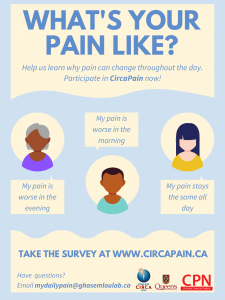A cross-Canada research team has launched the CircaPain project to learn why chronic pain might fluctuate throughout the day
Everyone feels pain differently, and most research studies have worked to understand where, why, and how it happens. However, there is little data available on when pain happens. The new CircaPain study is seeking help from Canadians living with chronic pain to better understand changes in their pain throughout the course of each day. Pain fluctuations, or lack thereof, could be related to the type of pain condition, sleep habits, or even where people live.
Regardless of pain severity, some people experience constant pain all day while others experience pain that changes throughout the day. This could mean fluctuations from day to day or fluctuations within the day. For example, some people may feel more pain in the morning than in the evening, while others have more pain in the winter than in summer.
It has been proposed that these fluctuations are linked to our 24-hour circadian rhythms (our sleep-wake cycles). These circadian rhythms influence a lot of what happens in our bodies, especially when it comes to the function of nervous tissue and immune cells. The nervous and immune systems are vital to our experience of pain, which is why understanding how these pain fluctuations occur is so important.
A team made up of researchers from Queen’s University, Kingston Health Sciences Centre, and the Université de Montréal is working together to dive a bit deeper into the relationship between the circadian system and chronic pain and find out why rhythmic pain fluctuations occur. For this project to be successful, the team needs as many people as possible to take part in the study.
The study is now recruiting participants and can be accessed at www.circaain.ca. It consists of two parts: the first is an online survey to understand study participants’ pain experience and daily habits (e.g., sleep/wake, coffee intake, etc.). Travel history and geographic location will also help the team learn whether daylight hours might play a role in pain. In the second part of the study, participants complete a 7-day electronic diary that collects data on their pain, mood, and other factors at three time points per day (8am, 2pm, and 8pm).
The CircaPain team hopes that the data collected in this study will provide individuals with a better understanding of their own pain, and in the process shed new light on how day/night changes might contribute to chronic pain. “We have the potential here to change how we think about pain, and spur the development of new personalized treatments across pain conditions,” said study lead investigator Dr. Nader Ghasemlou, an associate professor at Queen’s University.
Do you have questions about the study or want to learn more about the circadian control of chronic pain? Check out www.circapain.ca or email us at mydailypain@ghasemloulab.ca.
###
Support for this research is provided by the Canadian Chronic Pain Network, part of the Canadian Institutes of Health Research-Strategy for Patient Oriented Research program.




